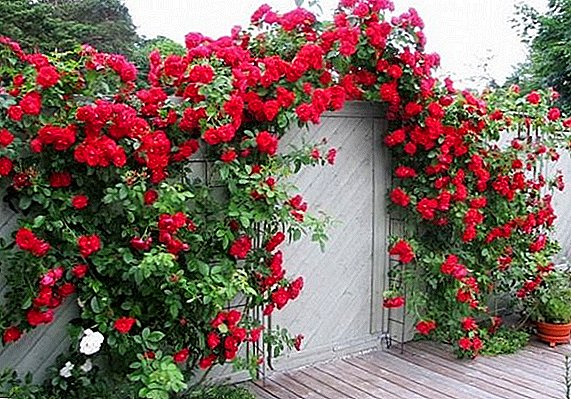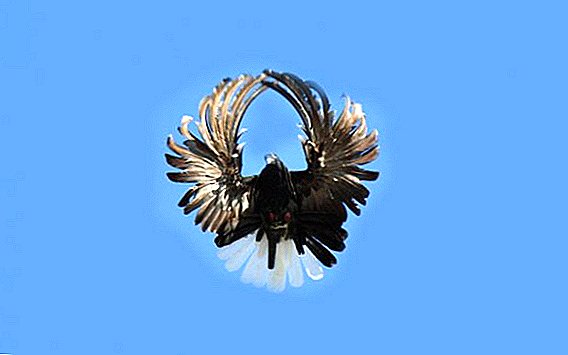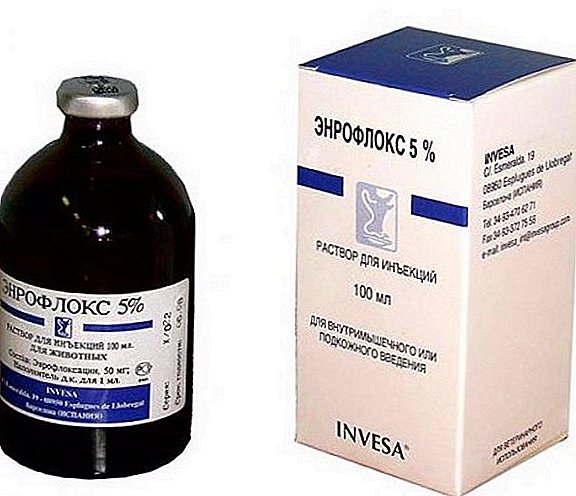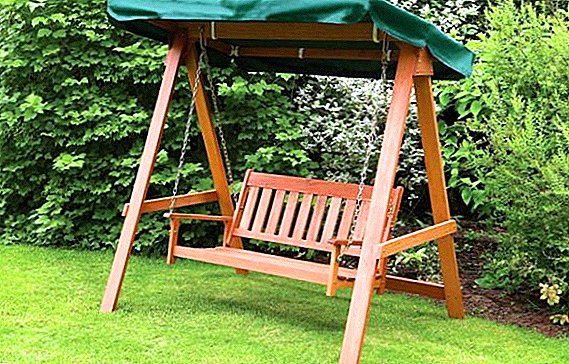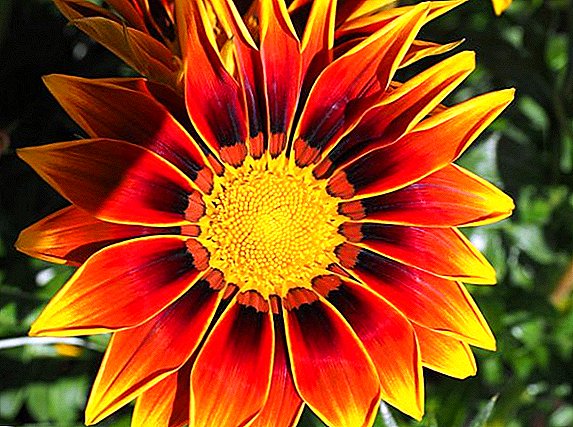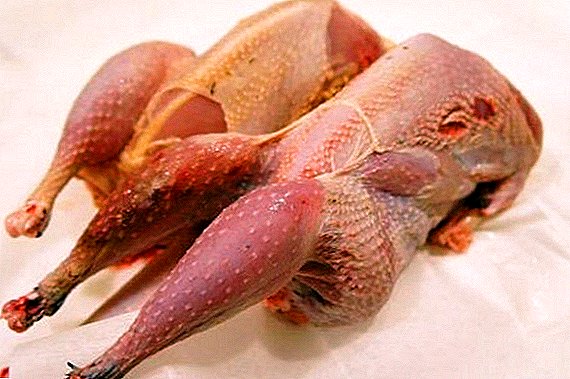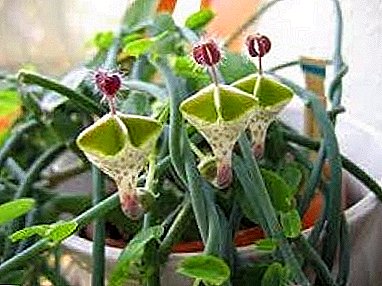
"Tsopegi Sanderson" - an evergreen flowering plant.
Loves abundant watering, good illumination and additional feeding.
Propagated by cutting. May be affected by spider mites.
general description
"Sanderson's tseropegiya" refers to the Asclepiadaceae family. Latin name: Ceropegia Sandersonii. In the wild, the plant grows on rocky beaches along the coast. Homeland is South Africa.
This representative of the flora also actively grows at home. It is bought for breeding in botanical gardens, greenhouses, greenhouses and balconies.
Reference! This perennial is an herbaceous evergreen, refers to the creeping form.
It has smooth, even, succulent branches of emerald hue. Shoots with a small number of leaves, almost naked. The length of the internode reaches no more than 18-22 cm. On each node there are two leaves with a short petiole. The shape of the leaves may be different.
In nature, you can find oval leaves, spherical, triangular or with a sharp tip. In length, the leaves reach about 5 cm. The leaf plate is shiny, curved. At the base has a heart shape. The reverse side of the leaves of a lighter shade. It has a wide thick vein.
A photo
The photo shows the plant "Tsopegiya Sanderson":





Home care
Bloom
 Plant blooms year-round. Peduncles have axillary shape.
Plant blooms year-round. Peduncles have axillary shape.
They are wide, thick, consist of a large number of even "links" of emerald hue. They are identical to the internodes of the stems. In length reach no more than 1 cm.
Each internode releases only one small bud. When the flower opens, its length can reach 8 cm.
The shape of the flower resembles a funnel. Aroma very pleasant, gentle. The upper side of the corolla merges into the dome. In shape, it resembles a five-fold star.
In the middle of the corolla white. And the edges of the flower have emerald touches. The inner side of the tube has a crimson hue. In place of the internode after flowering remains a deep scar.
Next to him will soon begin to grow a new bud. Flowers may begin to bloom in the same period or after a few years.
Reference! A distinctive feature of Tseropegiya Sanderson from other subspecies is elongated shoots.
Every year they become more and more elongated. They grow new internodes and buds.
Actions after purchase
 The plant is not common on the territory of the Russian Federation, Ukraine or Belarus. "Tseropegiya Sanderson" is a rare flower. On the shelves of its almost impossible to meet.
The plant is not common on the territory of the Russian Federation, Ukraine or Belarus. "Tseropegiya Sanderson" is a rare flower. On the shelves of its almost impossible to meet.
Therefore, sellers who have this representative of the flora, start to put too high prices.
Those lucky enough to buy this plant, you must follow some rules. For active growth flower needs a comfortable environment.
Watering
The plant likes abundant watering. It is necessary to wait for the top layer of the earth to dry. When watering you need to use warm soft water without chemical impurities. It is forbidden to flood the plant.
Otherwise, the root system starts to rot from an excess of water. Leaving perennial for a long time without water is not recommended, as the plant is not drought-resistant.
Important! "Tsyropegiya Sanderson" does not require high humidity.
But sometimes it can be sprayed from the sprayer and bathed under the stream of a warm shower. The land is pre-closed with a plastic bag.
Landing
 When planting it is necessary to use loose soil. It is important that the ground is well breathable.
When planting it is necessary to use loose soil. It is important that the ground is well breathable.
It is necessary to use a substrate of turf and leaf land with the addition of humus and fine-grained sea sand.
You can also use the purchase of primer for decorative cacti. In such a soil you need to add a small amount of perlite. To prevent the root system from rotting, charcoal is added to the mixture. At the bottom of the pot poured drainage of pebbles or broken bricks.
In the center set the plant. Sprinkle cooked soil. Plentifully watered and installed support. With her, the plant will actively grow.
Transfer
Young specimens require an annual transplant. Tanks choose a larger size. Adult flowers need a transplant 1 time in 2-3 years. It is best to use bowls or pallets. It is important that the diameter of the pot exceeds the height.
Fertilizer
With active growth in the ground must be purchased complex fertilizers. Both nitrogen and mineral are suitable. It is best to use fertilizer for orchids or decorative cacti. Application frequency: 1 time in 20-25 days.
Also recommend the use of organic dressing in the form of peat, humus or manure. It is important that fertilizers do not fall on the root system in the clear. In the winter you can not feed.
Breeding
 The most common breeding method is grafting. In early spring, a long stem should be cut from the main mother flower.
The most common breeding method is grafting. In early spring, a long stem should be cut from the main mother flower.
It is important that the escape had at least 3-4 internodes. Planting material is dried for 48 hours. Then attach the nodes to the wetted surface of the earth.
Slices should be raised so that they do not touch the ground. The seedling does not require mini-greenhouses. Rooting can occur at normal room temperature.
Temperature
Tseropegiya Sandersona loves a moderate temperature regime. Actively grows at 19-26 ° C.
Important! If during the winter period it is not possible to provide the flower with additional artificial additional lighting, then the temperature is reduced to 15 ° C.
In such conditions, the plant will have a period of rest and the stems will not greatly lengthen.
Lighting
Refers to the light-loving plants. For active growth and abundant flowering it needs illumination of 3900-6100 lux. The flower prefers 12-hour year-round lighting. In winter, when there is very little light, this representative of the flora is illuminated artificially. Otherwise, the stems will be elongated. The plant will cease to bloom.
Important! The flower does not tolerate direct sun.
In hot weather, the leaves of the plant can wither and quickly fade. Then they turn yellow and fall off. Therefore, to place this pet on the southern sides is strictly prohibited.
- Dikhorizandra;
- Syngonium;
- Tetrastigma Vouinier;
- Dusheneyya Tutti Frutti Indian;
- Setcreasia Violet (purple);
- Ruellia;
- Money plant (Potos);
- Tolmia;
- Philodendron;
- Thunbergia
Diseases and pests
 Pests plant is affected very rarely. A spider mite may appear. It is washed off with soapy water. Also sometimes aphid appears. In this case it is necessary to spray the flower with chemicals.
Pests plant is affected very rarely. A spider mite may appear. It is washed off with soapy water. Also sometimes aphid appears. In this case it is necessary to spray the flower with chemicals.
Fitoverm, entobakterin, boom, tanrek, biotlin are perfect.
Diseases occur with improper care. Sunburn occurred while twisting the leaves. With the appearance of brown spots - rotting of the root system.
If the stems began to be strongly drawn out, then the plant needs more light. If “Sanderson's Tseropegiya” ceased to bloom, then it needs fertilizing and the most nutritious soil. Also, the termination of flowering can be the result of improper wintering.
"Tsopegiya Sanderson" - flowering ornamental plant. He likes nutritious soil, abundant watering, well-ventilated sunny rooms. It responds well to top dressing. Actively grows at 19-26 ° C.


